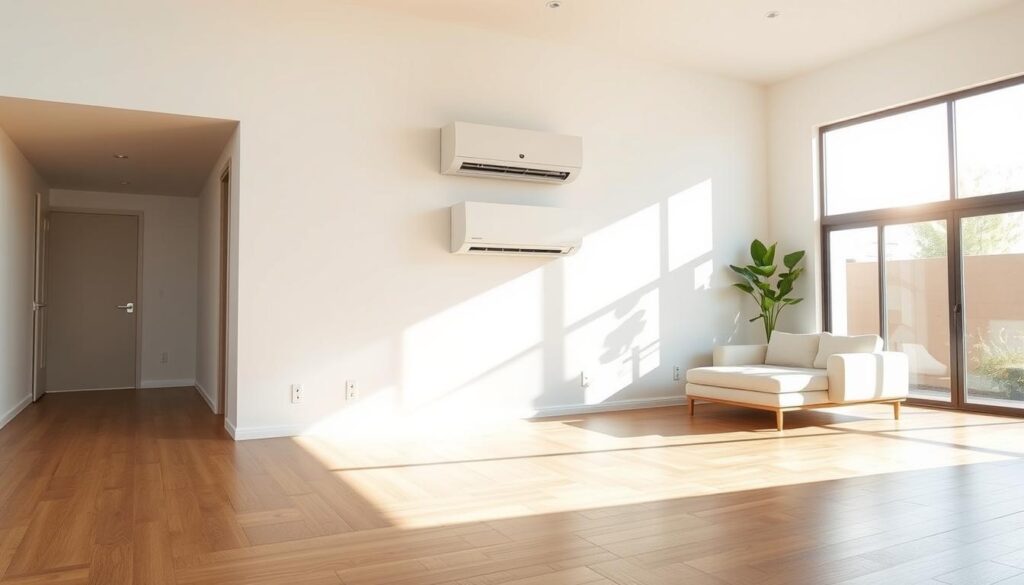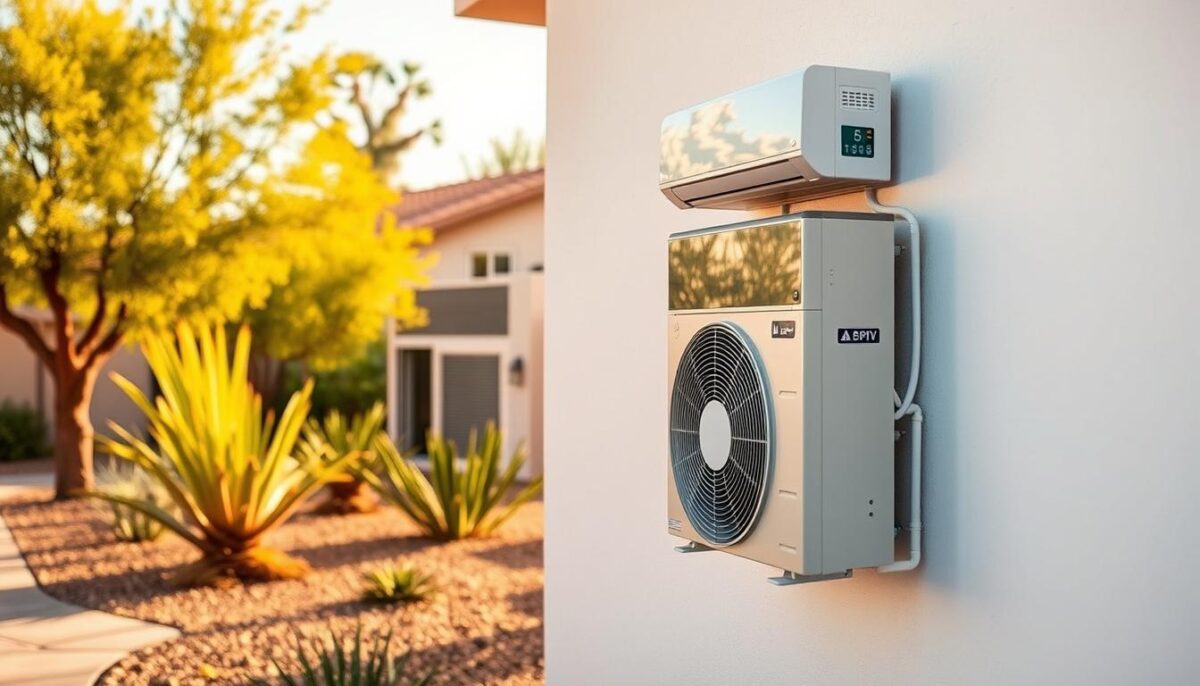How Much Does Mini-Split Installation Cost in Arizona?
Arizona’s desert climate poses unique challenges for home cooling, making efficient cooling systems a necessity. The cost of installing a mini-split system in Arizona can vary widely, typically ranging from $2,000 to $10,500.
This variation in cost is due to several factors, including the local market conditions, the condition of the home, and the specific requirements of the cooling system needed.
Understanding these factors is crucial for homeowners to make informed decisions about their cooling solutions.
Key Takeaways
- Average cost range for mini-split systems in Arizona.
- Factors influencing the total cost of the system.
- Importance of energy efficiency in Arizona’s climate.
- Difference in cost between single-zone and multi-zone systems.
- Impact of extreme heat on system selection and installation.
Understanding Mini-Split Systems in Arizona’s Climate
Arizona’s harsh desert climate demands efficient cooling solutions, making mini-split systems an increasingly popular choice among homeowners. To appreciate their growing popularity, it’s essential to understand what mini-split air conditioners are and why they’re particularly suited to Arizona’s climate.
What Are Mini-Split Air Conditioners?
Mini-split air conditioners, also known as ductless mini-splits, are heat pump systems that provide both cooling and heating. They consist of an outdoor unit connected to one or more indoor units, allowing for zoned cooling and heating. This setup enables homeowners to control the temperature in individual rooms or zones, enhancing comfort and potentially reducing energy consumption.
Unlike traditional HVAC systems that rely on ductwork to distribute air throughout a home, mini-splits deliver conditioned air directly into the space, eliminating duct losses and improving overall efficiency.
Why Mini-Splits Are Popular in Arizona
Several factors contribute to the popularity of mini-splits in Arizona. Their high efficiency ratings are particularly valuable in a state where cooling systems operate for extended periods. Additionally, the zoned cooling capability allows homeowners to cool only occupied rooms, saving energy during the long, hot seasons.
- Flexibility for diverse housing styles, from historic homes to modern construction
- Ability to handle extreme temperature swings between day and night
- Ideal for home additions, sunrooms, and garage conversions common in Arizona’s expanding housing market
These benefits make mini-splits an attractive option for Arizona homeowners seeking efficient and flexible cooling solutions for their home.
Average Mini-Split Installation Cost in Arizona

Mini-split AC installation costs in Arizona are influenced by various factors, making it essential to understand the pricing for different system configurations. The type of mini-split system chosen significantly impacts the overall cost.
Single Zone System Costs
A single-zone mini-split system is ideal for smaller homes or rooms. For a 36,000 BTU Mini-Split with 1 head, the cost is around $10,725.64. This cost includes both the equipment and installation expenses.
Single Zone System Cost Breakdown:
| BTU Rating | Cost |
|---|---|
| 36,000 | $10,725.64 |
Multi-Zone System Costs
For larger Arizona homes, multi-zone systems are often more efficient. The cost increases with the number of zones. For instance, a 36,000 BTU Mini-Split with 2 heads costs $12,671.64, while a system with 5 heads costs $15,564.64.
Multi-Zone System Cost Comparison:
| Number of Heads | Total Cost |
|---|---|
| 1 | $10,725.64 |
| 2 | $12,671.64 |
| 3 | $13,186.64 |
| 4 | $14,135.64 |
| 5 | $15,564.64 |
Breakdown of Mini-Split Installation Expenses
When planning for a mini-split installation, it’s essential to break down the various expenses involved. This breakdown will help homeowners in Arizona understand where their money is going and make informed decisions about their investment.
Equipment Costs
The cost of the mini-split equipment itself is a significant portion of the total installation expense. This includes the indoor unit, outdoor unit, and any additional components required for the system to function properly. High-quality equipment from reputable brands like Carrier and Daikin can be more expensive upfront but may offer better efficiency and longer lifespan.
Labor Costs
Labor costs are another substantial component of mini-split installation expenses. The complexity of the installation work and the rates charged by contractors can vary significantly. It’s crucial to hire experienced professionals who can ensure a proper installation, as this directly impacts the system’s performance and longevity.
Additional Materials and Supplies
Beyond the main equipment, several additional materials are necessary for a complete mini-split installation. These include mounting hardware, electrical connections, refrigerant lines, drain lines, and insulation materials specifically chosen for Arizona’s climate conditions. The length and complexity of the refrigerant lines can significantly affect the overall cost, as longer or more complex installations require more materials and labor.
Specialized materials may be needed to withstand Arizona’s extreme heat, including weatherproofing and UV-resistant components for outdoor units. Electrical requirements and potential panel upgrades also contribute to the total material costs.
Factors That Influence Mini-Split Installation Cost
Several factors can significantly impact the overall cost of mini-split installation in Arizona. Understanding these elements is crucial for homeowners to budget accurately and make informed decisions about their cooling systems.
Size of Your Home or Room
The size of your home or the specific room you want to cool plays a significant role in determining the cost of mini-split installation. Larger spaces require more powerful systems, which can increase equipment costs. Additionally, the number of rooms or zones you want to cool will affect the overall price, as multi-zone systems are generally more expensive than single-zone ones.
System Capacity and BTU Requirements
System capacity, measured in British Thermal Units (BTUs), is another critical factor. A higher BTU rating indicates a more powerful cooling capacity. The BTU requirements for your home depend on factors such as insulation, window size, and local climate conditions. An HVAC professional will assess these factors to recommend the appropriate system capacity, directly influencing the installation cost.
Energy Efficiency Ratings (SEER2, EER2, HSPF2)
Energy efficiency ratings, including SEER2, EER2, and HSPF2, significantly impact the cost and performance of mini-split systems. Higher efficiency ratings often result in higher upfront costs but can lead to substantial long-term savings on energy bills. Arizona’s hot climate makes energy-efficient systems particularly beneficial.
Installation Complexity
Installation complexity is a significant factor that can affect the overall cost. This includes considerations such as:
- Installation location and accessibility
- Length and routing of refrigerant lines
- Electrical requirements and potential panel upgrades
- Special considerations for historic homes or complex architectural designs
| Installation Complexity Factor | Impact on Cost |
|---|---|
| High wall installation vs. in-ceiling | Increases labor time and potentially requires additional materials |
| Long refrigerant lines | Requires more material and can increase labor costs |
| New installation vs. replacement | New installations may require additional work, such as electrical upgrades |
By understanding these factors, Arizona homeowners can better anticipate the costs associated with mini-split installation and make more informed decisions about their cooling solutions.
Single Zone vs. Multi-Zone Mini-Split Systems
When considering mini-split systems for your Arizona home, one of the key decisions you’ll face is whether to opt for a single-zone or multi-zone setup. A single-zone system provides comfort to one room or area and includes one outdoor unit and one indoor unit. In contrast, multi-zone systems can provide separate comfort control in several areas with 2-5 indoor units connected to one outdoor unit.
Cost Comparison
The cost of single-zone and multi-zone mini-split systems varies significantly. Single-zone systems are generally less expensive upfront, with costs starting at around $1,500 for the equipment and installation. Multi-zone systems, while more expensive initially, can offer greater flexibility and potentially lower overall costs for larger homes or homes with multiple areas that require cooling.
| System Type | Equipment Cost | Installation Cost | Total Cost |
|---|---|---|---|
| Single-Zone | $1,000 – $2,000 | $500 – $1,000 | $1,500 – $3,000 |
| Multi-Zone | $2,500 – $5,000 | $1,000 – $2,500 | $3,500 – $7,500 |
Which Option Is Right for Your Arizona Home?
Choosing between a single-zone and multi-zone mini-split system depends on several factors, including your home’s layout, your family’s cooling needs, and your budget. For homes with multiple rooms or areas that require separate temperature control, a multi-zone system may be the more practical choice. On the other hand, single-zone systems are ideal for smaller homes or rooms that require individual cooling.
Consider your specific needs and circumstances. If you have a vacation home or rental property with fluctuating occupancy, a multi-zone system can offer greater flexibility and energy efficiency. For a primary residence with consistent occupancy, a single-zone system might suffice for individual rooms.
Top Mini-Split Brands and Their Cost Range
Selecting the right mini-split brand is crucial for Arizona residents, where extreme temperatures demand high-quality HVAC systems.
Premium Brands
Premium brands like Carrier and Daikin offer high-quality mini-split systems known for their reliability and advanced features. These brands are particularly suited to Arizona’s extreme climate.
Mid-Range Options
Mid-range brands such as LG and GE provide a balance between price and quality. They offer competitive features at a lower cost than premium brands, making them an attractive option for many homeowners.
Budget-Friendly Choices
For those on a tighter budget, brands like Senville or Fujitsu offer more affordable options. While they may not match the reliability of premium brands, they can be suitable for certain applications, such as rental units or temporary spaces.
When choosing a mini-split brand, it’s essential to consider not just the upfront price of the unit, but also the long-term quality and reliability of the system. Premium brands may offer better durability and performance in Arizona’s challenging climate.
New Installation vs. Replacement Costs
The cost of mini-split installation in Arizona can vary significantly depending on whether you’re installing a new system or replacing an old one. Understanding these costs is essential for making an informed decision.
First-Time Installation Expenses
First-time mini-split installation involves several expenses, including the cost of the unit itself, labor, and additional materials. The total cost can range widely based on factors such as the size of the area to be cooled and the complexity of the project.
A typical new installation requires a thorough assessment of the home’s cooling needs, selection of appropriate equipment, and professional installation. The cost of the equipment can vary based on the brand, model, and features.
Replacement Cost Considerations
Replacing an existing mini-split system can be more cost-effective than a new air conditioner installation, as some components may be reused. However, it’s crucial to evaluate the condition of existing parts and ensure compatibility with the new unit.
When replacing a mini-split system, several factors must be considered, including the condition of the line set, the need for a vacuum pull before opening the king valve, and calibration of freon levels. A checklist can help ensure that all necessary steps are taken:
| Replacement Checklist | Status |
|---|---|
| Is the line set cleaned using an acid flush before hookup? | Yes/No |
| Is a vacuum pulled before opening the king valve (if required)? | Yes/No |
| Are the freon levels calibrated? | Yes/No |
| Is the communicating wire between the condenser and heads hooked up correctly? | Yes/No |
| Are the condenser and heads level? | Yes/No |
By carefully evaluating these factors and using a replacement checklist, homeowners can ensure a successful and cost-effective replacement project.
Ways to Save on Mini-Split Installation in Arizona
To minimize expenses on mini-split installations, Arizona residents can leverage various cost-saving opportunities. By understanding the factors that influence installation costs and exploring available incentives, homeowners can enjoy efficient cooling without overspending.
Seasonal Timing for Best Pricing
Timing is everything when it comes to saving on mini-split installations. Scheduling your installation during the off-season (usually fall or spring) can result in better pricing due to lower demand. Contractors may offer discounts or promotions during these periods to keep their businesses busy.
Rebates and Tax Credits Available in Arizona
Arizona homeowners may be eligible for rebates and tax credits that can significantly reduce the cost of their mini-split installation. Utility companies and government programs often offer incentives for energy-efficient installations. It’s essential to research and take advantage of these programs to lower your upfront costs.
Getting Multiple Quotes from Contractors
Obtaining multiple quotes from licensed contractors is a crucial step in saving on mini-split installation. By comparing prices, services, and equipment quality, homeowners can make informed decisions. Look for detailed estimates that include labor costs, materials, warranty terms, and the brand of equipment being used. This transparency helps in identifying the best value for your investment.
DIY vs. Professional Installation: Cost Analysis
Arizona homeowners considering mini-split installation face a critical decision: whether to undertake the installation themselves or hire a professional. This decision can significantly impact both the upfront and long-term costs of the system.
Risks of DIY Installation
While DIY installation may seem cost-effective initially, it comes with significant risks. Improper installation can lead to inefficiencies, safety hazards, and potentially void the manufacturer’s warranty. Arizona’s extreme climate demands precise system sizing and calibration, which is challenging for non-professionals.
- Inefficient system performance due to incorrect sizing
- Potential safety risks from improper handling of electrical and refrigerant components
Benefits of Hiring a Professional
Hiring a professional contractor ensures that the installation is done correctly, maintaining the system’s efficiency and warranty. Professionals can properly size the system for Arizona’s climate, charge the refrigerant correctly, and calibrate the system for optimal performance.
- Ensured compliance with Arizona-specific code requirements and permit processes
- Ongoing service relationships and warranty protection
Making the Right Investment for Your Arizona Home
For Arizona homeowners, a well-designed mini-split system can significantly improve home comfort while providing long-term savings. When evaluating the investment in such a system, it’s essential to consider factors beyond the initial installation cost.
A quality cooling system can increase your home‘s value and enhance your living experience. The energy efficiency of a mini-split system can lead to substantial savings over its lifetime, especially in Arizona’s extended cooling season.
By balancing the upfront costs against the long-term benefits, homeowners can make an informed decision that suits their needs and budget. This approach ensures that the system provides both comfort and financial benefits in the long run.




